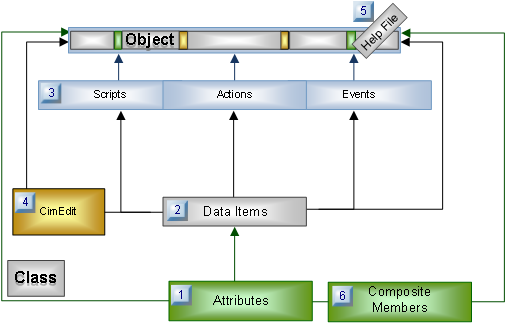Overview: Class Instantiation Process
Class: Class Configuration
Configuring features for a class is similar to configuring features in a project. The class includes some additional functionality to enable a class developer to create a flexible template that can serve as the basis for many objects.
- Features included in a class template.
- Class dialog box.
- Classes listed.
Features Included in a Class Template
The following features can be included in class template.

| Tool | Use | ||
| 1 | Attributes (variables) | Numeric or string placeholders to which values will be assigned when instantiating the object. Provide the flexibility required to insure that the class has the range of possible values among objects that are created from the class. Note: When you configure the class, you specify how the attribute can and will be dealt with by an object designer. | |
| 2 | Data items | Data items make use of the attributes' flexibility by Incorporating attributes in their definitions. There are the templates for points that will be instantiated when objects are created. | |
| 3 | Scripts/Actions/Events | Scripts, actions and events can include data items in their configuration. | |
| Scripts | Apply to all objects in the class.. | ||
| Actions | Apply to all objects in the class | ||
| Events | Apply to all objects in the class for triggering actions. | ||
| 4 | CimEdit Graphic File | A CimEdit screen that includes one or more class objects can be associated with a Class. Any of the CimEdit graphic class objects can be used on an object screen; one can be selected as the default. Any of the CimEdit graphic class objects can also incorporate data items that hold the place for the class objects' instantiated points. | |
| 5 | Composite Members | Composite members are references to other classes. They can have their own data items, events, and actions. | |
Class Dialog Box
Class entries are made in a Class dialog box.

| Field | Use |
|---|---|
| Faceplate | The faceplate screen is a screen you can add to the class. When the class has a faceplate associated with it, anytime you left click on a class object in a screen its does a popup of the faceplate screen, and assigns the $OBJECT variable on the faceplate with the $OBJECT variable value of the class object that was clicked on. The faceplate screen is automatically shown with a dialog border, and basically does the same thing that the PPS global faceplate script did. |
| Class Version | The class version is automatically incremented when there is a structural change to the class. This include adding or removing data items, and composite members. The class editor can also manually assign to version also. When doing class imports, if the version of the class is lower than the current class version, there will be a warning that you are importing a lower version number over a higher version number. |
Classes Listed
Classes that have been created are listed in the Workbench right pane. These classes can be exported from projects or imported into projects.
Object: Object Configuration
A class object is a quickly created set of project features that are included in its class template.
- Object based on class.
- Object dialog box.
- Objects listed.
Object Based on Class
Objects can be created using any class as its template.

Object Dialog Box
Entries to define a class object are made in an Object dialog box. Fields and tabs that are included in the dialog box are based on the selected Class configuration.

Objects Listed
Objects that are created are listed in the Workbench right pane.

Instantiation: Features Enabled
Each object includes a full set of features instantiated from the class on which it was created.
- Attribute placeholders are replaced by values that are associated with class objects.
- Data items are replaced by points whose ID's include an object ID prefix.
- Scripts whose ID's include a class ID prefix are applied to the object.
- Actions whose ID's include an object prefix are listed in the Event Manager.
- Events whose ID's include an object prefix are listed in the Event Manager.
- CimEdit/CimView screens that incorporate selected class containers are available.




